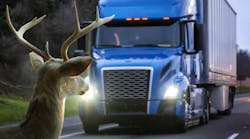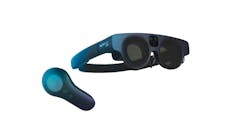Editor's Note: This is Part One of a two-part story.
Ah, springtime in the Midwest! The time of rebirth, renewal, and warmer weather. Blossoming trees of pink and white paint the hills, while the air is filled with their sweet fragrance, along with bustling birds making nests and busy bees collecting pollen. But there’s also a danger that should strike fear into the hearts of fleet maintenance managers. Deadly animals—who also know plenty about the birds and bees and got busy last fall—are starting to spawn new deceptively adorable offspring that will soon terrorize the roadways, indiscriminately throwing their weight and antlers around like they own the place. Yes, we’re talking about deer.
According to State Farm, 1.9 million collisions between deer and vehicles occurred in the U.S. between July 2021 and June 2022, with the most auto claims made in Pennsylvania (156,176). But you are more likely to hit a deer in neighboring West Virginia, where the country roads are far more precarious than John Denver would have you believe. You have a 1 in 35 chance of striking a deer or other animals there. This not only results in deer becoming roadside venison, but puts people’s lives at risk. The Ohio State Highway Patrol reported that from 2017 through August 2022, there were 101,912 deer-vehicle collisions and 31 people were killed in the Buckeye State. Twenty of these were riding motorcycles, but deer can instill a sense of dread in the heavy-duty trucking sector.
“It’s a little unnerving at night when you’re looking out and you just see these eyes looking back at you all along the side of the road,” sighed Taki Darakos, VP of maintenance at Pitt Ohio, a carrier that often performs linehaul operations at night through West Virginia.
Darakos feels uneasy because he knows even hulking heavy-duty trucks are at risk when these hoofed menaces dart across the highway. A solid deer impact won’t total one of Pitt’s Mack Anthems but could damage the hood, body, and grille. And these collisions lead to extended downtime—on average two days or more—and expensive repairs. That’s why fleets should go beyond telling drivers to just be more alert during certain times of day and year; they should also take preventive action through spec’ing grille guards and preparing the technicians in the bay for the inevitable mess with a proper action plan.
First, let's look at the potential cost of a deer strike and the impact on uptime.
The damage
“Typically, if there’s a deer strike without a grille guard, there’s a good chance that truck can be immobilized,” Darakos said. “You could lose the radiator charge air cooler—if you’re running collision mitigation, there’s a good chance you’re gonna take out the radar unit. Depending on just where the deer is when you hit it, you could have a $10,000 or $12,000 strike.”
And during the deer rutting season in October and November, Darakos said Pitt will hit upwards of 150 deer. The fleet has 800 Class 8 tractors and 600 straight trucks. Many of these operate in city delivery applications where speeds are slower and deer scarce. Even considering that, 10% of Pitt’s trucks hit deer per year.
“A big reason why we’re so susceptible to deer strikes is that we run about two-thirds of our tractor fleet in linehaul operations, heading out in early dusk,” he said. “That’s just when a lot of the deer are moving and it just exposes us.”
Robert “Bert” Derrick, manager of fleet maintenance at Pitt Ohio, noted that more than half of the fleet’s 150 deer hits are not severe, though. But even if only 70 are, that leads to $700,000 in repair costs and at least 140 days of uptime lost. This also puts more stress on the body shop, parts department, and other areas of the company.
Related content: How to maximize uptime after a collision
“The damage today is much more expensive than 25 years ago because the deer used to bounce off the bumper,” said Derrick, because truck OEMs implemented fiberglass bodies and bumpers over sturdier metal components for lightweighting purposes. “Now it just crushes the bumper.”
Internal components can also suffer and lead to major repairs. Derrick said transmission cooler lines have been torn off, destroying the powertrain.
“We’ve actually lost transmissions due to the transmission fluid coming up,” he said, adding the collision avoidance systems on the front of the trucks also can increase repair costs. At one point, radar sensors had cost up to $3,000, though now have come down in price. During the pandemic, these were also difficult to get, extending downtime.
According to industry data compiled by PPG’s AdjustRite commercial estimating system, the cost of repairing front-end severity, which includes parts, supplies, materials, etc., is on the rise for Classes 1 through 8. Factoring for any front-end damage (left front, front, and right front), AdjustRite reported increases YOY from 2021 to 2022. Tractor repairs rose the most with 24% to $13,317, and medium-duty the least at 6% to $12,726. Light-duty rose 20% to $13,254 and heavy-duty 17% to $16,083.
The fix
So what should shops do if they receive a truck covered in fur and blood?
The first thing is too clean the body, advises Ben Cole, the lead estimator and office manager at Fleet Fast. He’s also the Akron-based commercial vehicle body shop’s unofficial “deer guts remover.”
“Make sure that the truck is washed prior to the techs performing repairs,” Cole said. “Deer can spread blood, excrement, and ticks across the body of the vehicle. If not sanitized, this can cause health issues for techs including Lyme disease.”
If the truck is drivable, Fleet Fast runs the vehicle through a truck wash before taking it to the shop. After that, the assigned technician suits up head to toe in PPE (typically worn for painting) and pressure washes the affected areas.
“Mild detergents like dish soap will typically work to remove the organic matter, but for stubborn spots, enzyme-based cleaners can help break down the organic matter,” Cole said. “Then we always follow up with spraying all the parts down with isopropyl alcohol to sanitize for tech safety.”
On the estimating side, Cole said to “perform a detailed inspection of the damage, including the frame, suspension, steering components, and cooling system” and take photos and videos.
“When estimating a deer hit specifically, make sure to check locations on the truck for damages other than just the primary impact spot,” Cole continued. “When a deer hit occurs, the carcass can be thrown across the vehicle and sometimes damage parts as far as the rear of the vehicle when the primary impact was on the front end. It can also damage the undercarriage by driving over the carcass.”
Related content: Study reveals Wyoming most dangerous for truckers; Michigan safest
He also recommends using estimating software to account for labor, part costs, and other services needed, and to reduce errors. Fleet Fast uses the AdjustRite system.
When making repairs, Cole said to follow OEM practices, use quality parts, and, of course, test drive the vehicle to ensure proper alignment.
Pitt Ohio’s Derrick downplayed the messiness of these incidents, saying, “Maybe there’s a little bit of blood and guts,” but for the most part, the deer bounce off. There was that one time though where a Pitt truck hit two cows on the highway.
“That was a mess,” Derrick recalled. “Deer hits, not so much.”
The biggest mess could be parts availability, but Pitt mitigates this by having adequate inventory. For example, they stock two or three spare hoods for each type of truck they run at the main warehouse in Pittsburgh. Because linehaul trucks head out to each terminal from Pittsburgh every night, it’s easy to load those parts, like a replacement hood, in the trailer and have them the next day.
“They’ll switch the hoods and send that damaged hood back and we’ll rebuild it and put it back in inventory,” Derrick explained.
This means the average downtime due to the hood is only two days, but the total time can be much more. According to AdjustRite data, last year the average labor hours for a heavy-duty truck front-end collision were:
- Body: 20.7 hours
- Frame: 12.9 hours
- Mechanical: 15.1 hours
- Paint: 12.5 hours
That’s a total of 61.2 hours if all areas need to be repaired. Independent shops like Fleet Fast would welcome that kind of business, but fleets would do well to avoid major damage altogether.
In Part 2, we'll cover how to mitigate deer-vehicle collisions.





